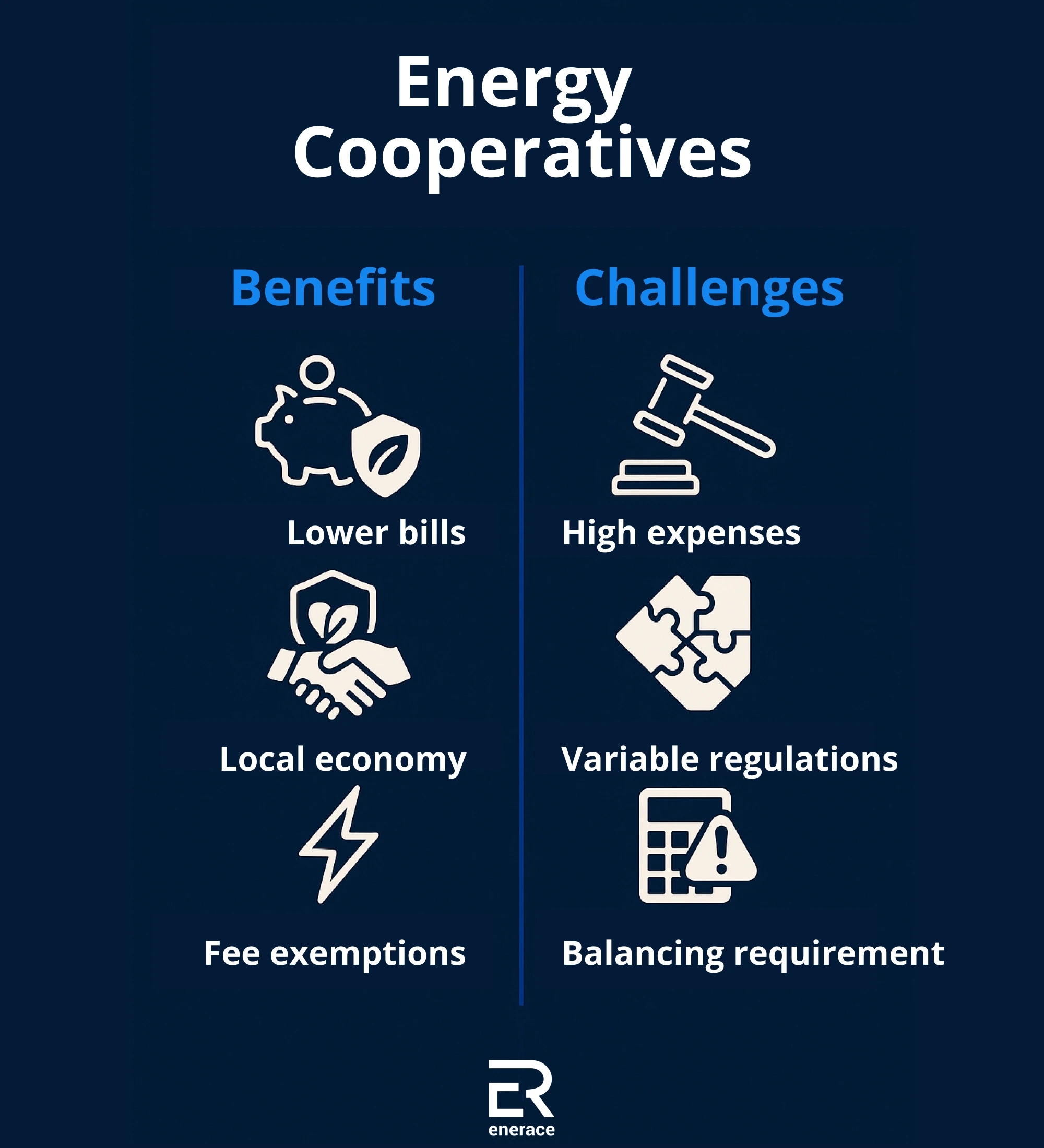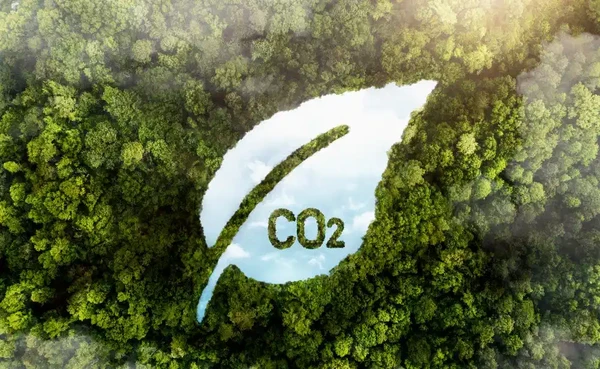
Energy Cooperatives – a Chance for Cheaper Power?
Energy cooperatives are a new route to energy self-sufficiency and lower electricity bills. This article explains what an energy cooperative is, the requirements you must meet, and the benefits and challenges that await investors.
What is an energy cooperative?
An energy cooperative is a new form of collaboration between businesses, local authorities and other entities, enabling members to achieve real savings on energy costs. Its activity is based on renewable energy sources (RES) such as heat, photovoltaics, biogas plants or biomethane plants in order to meet the energy needs of cooperative members. But is the model really profitable for large companies, and how does it work in practice?
Operating models of energy cooperatives
An energy cooperative can function in two ways:
- Joint-asset model - RES installations belong to the cooperative; energy is settled in proportion to membership shares.
- Distributed model - Installations belong to individual members; energy is traded internally within the cooperative.
What conditions must an energy cooperative meet?
To obtain cooperative status, the entity must be entered in the National Court Register (KRS) and listed in the register maintained by the National Support Centre for Agriculture (KOWR). Activity may take place in no more than three adjoining rural or urban-rural communes. For energy-generation activities, the following capacity limits apply:
- 10 MW for photovoltaic installations (generation must cover at least 70 % of members’ demand, except during the transition period until 31 Dec 2025, when the threshold is 40 %),
- 30 MW for thermal installations,
- 40 million m³ per year for biogas or agricultural biogas plants,
- 20 million m³ per year for biomethane plants.
Settlements and Obligations
The cooperative settles accounts with the distribution system operator (DSO) and the energy seller. The DSO provides metering data for all generators and consumers, on the basis of which the seller settles energy at a 1 : 0.6 ratio. This means that for every 1 kWh fed into the grid, the cooperative may draw 0.6 kWh within the next 12 months. The remaining 40 % of the energy’s value stays with the seller to cover settlement costs and fees.
The cooperative must submit an annual report to KOWR and undergo an audit ( lustracja ) at least once every three years (annually if in liquidation).
The cooperative must submit an annual report to KOWR and undergo an audit ( lustracja ) at least once every three years (annually if in liquidation).
Energy Cooperatives – Are They Worth It?

An energy cooperative can significantly cut energy costs and strengthen the local economy, but it requires capital and resilience to regulatory change. Below we analyse all the pros and cons.
Benefits for Cooperative Members
Energy produced and consumed within the cooperative—including the portion settled at 1 : 0.6—is billed on preferential terms and exempt from:
- fees for energy settlement payable to the seller,
- variable distribution fees payable to the DSO,
- the RES levy,
- the cogeneration levy,
- the capacity fee,
- the obligation to present origin certificates for cancellation.
Challenges and Recommendations
Despite growing potential, energy cooperatives face several hurdles. The biggest challenges include high upfront investment costs and a lack of widely accessible financing instruments. Frequent legislative changes and ambiguous regulations create legal risk. Territorial limits (maximum three neighbouring communes) and balancing requirements (meeting a defined share of demand) can hamper larger projects.
To minimise risks and increase the chance of success, professional legal and technical advice is recommended as early as the planning stage. Cooperation with experienced industry partners—such as energy trading companies or RES developers—is also crucial, as is preparing a well-thought-out statute and business model. Remember too that submitting an application to KOWR before 31 December 2025 lets you benefit from the reduced balancing threshold of 40 %.
To minimise risks and increase the chance of success, professional legal and technical advice is recommended as early as the planning stage. Cooperation with experienced industry partners—such as energy trading companies or RES developers—is also crucial, as is preparing a well-thought-out statute and business model. Remember too that submitting an application to KOWR before 31 December 2025 lets you benefit from the reduced balancing threshold of 40 %.
Energy Cooperatives – Summary
Energy cooperatives offer a genuine opportunity for cheaper, greener power and for strengthening local communities and economies. A well-prepared project can respond to the challenges of the energy transition and reduce exposure to wholesale-market price swings. Such solutions can also help meet climate targets and increase the energy resilience of regions.
FAQ: Energy Cooperatives 2025
What is an energy cooperative?
An energy cooperative is a form of collaboration between entities (e.g., companies, municipalities, institutions) that organizes the generation, balancing, and use of renewable energy within a community.
What is the purpose of an energy cooperative?
Its purpose is to reduce energy costs, increase local energy independence, and make efficient use of local renewable resources.
Who can establish an energy cooperative?
Entities with a shared energy interest in a defined area (e.g., municipalities, businesses, public institutions, farmers) can establish a cooperative, provided they meet formal and legal requirements.
What are the key benefits of an energy cooperative?
Lower bills thanks to local generation and internal settlements, greater cost predictability, environmental benefits, and strengthening of the local economy.
What operating models of energy cooperatives exist
Most commonly: a shared-assets model (installations owned by the cooperative) and a distributed model (installations owned by members, with energy balanced within the cooperative).
How is energy settled in an energy cooperative?
Settlements cover balancing of members’ generation and consumption under rules set by regulations and contracts (with the grid operator and energy supplier) to maximize autoconsumption and minimize purchases from the grid.
What are the main challenges when creating an energy cooperative?
High upfront investment needs, legal and administrative complexity, and the need to match the generation profile to members’ demand.
What risks apply to energy cooperatives?
Regulatory change risk, uncertainty of RES prices and production, and the risk of mismatches between consumption profiles and generation.
Where should you start when creating an energy cooperative?
Begin with analyzing consumption profiles and RES potential, selecting the operating model, arranging financing, and completing the registrations and contracts required for balancing and settlements.
For whom does an energy cooperative make the most sense?
For groups with complementary load profiles (e.g., day/night or seasonal) that can effectively use local RES generation and achieve economies of scale.
Legal Acts and Sources:
- Co-operative Law Act of 16 September 1982 (Journal of Laws 2021 item 648)
- Renewable Energy Sources Act of 20 February 2015 (Journal of Laws 2024 item 593)
Author: Aleksandra Ślusarczyk, Consultant



